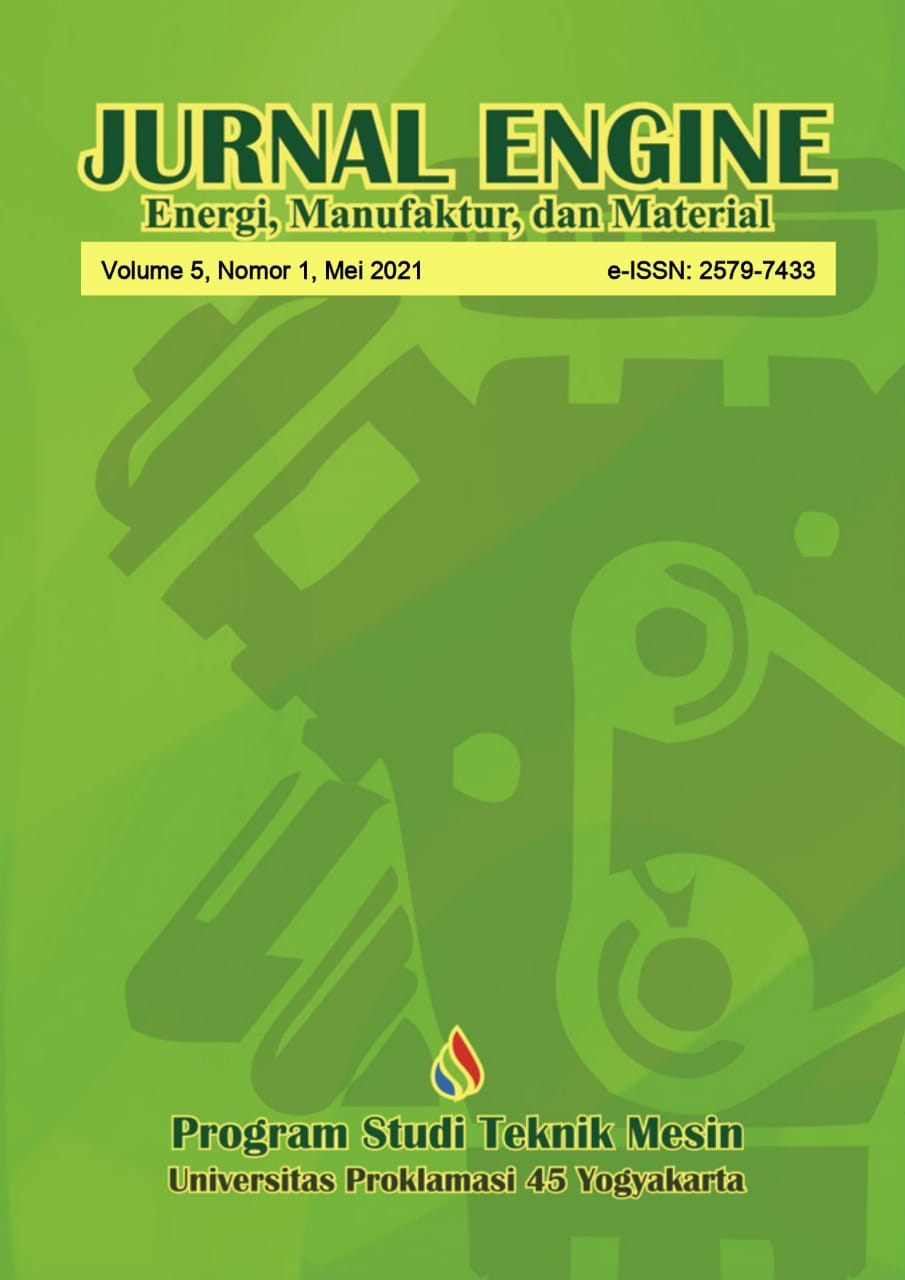Simulasi Lemari Pengering Tenga Surya Dengan Prisma Kaca Menggunakan Computational Fluid Dynamics
DOI:
https://doi.org/10.30588/jeemm.v5i1.830Keywords:
lemari pengering, panas, simulasi, temperaturAbstract
Lemari pengering merupakan bagian penting pada pemanas udara tenaga surya. Lemari pengering diharapkan mampu menyimpan panas dalam waktu yang lama. Hal tersebut menyebabkan analisa thermal pada lemari pengering perlu dilakukan. Tujuan dari penelitian ini adalah untuk mengetahui karakteristik termal dan aliran yang terjadi pada lemari pengering. Karakteristik tersebut antara lain distribusi temperatur, perubahan temperatur dan kecepatan, dan pola aliran udara. Metode yang digunakan pada penelitian ini adalah Finite Volume Method berupa simulasi menggunakan software komputasi fluida atau Computational Fluid Dynamics, simulasi menggunakan model tiga dimensi pada kondisi transient dengan time step 0.015. Data simulasi diambil saat 5 detik, 15 detik, 25 detik, dan 35 detik. Hasil simulasi diperoleh perubahan distribusi temperatur udara terhadap waktu yang terjadi pada bidang XY dan bidang XZ lemari pengering. Berdasarkan hasil simulasi diketahui terjadi penurunan temperatur udara. Temperatur udara tertinggi terjadi pada bagian bawah lemari pengering dengan temperatur udara sebesar 331 K. Prisma kaca pada bagian atas lemari pengering mampu memberikan panas pada udara. Terjadi aliran balik di dalam lemari pengering yang menyebabkan udara panas dari saluran masukkan tidak terdistribusi merata.
References
Rahul, K.,S, Goswani., M, Anas., S, Sharma., Satvik, A., & Shivansh, A. (2020). Performance Evaluation of an Arched Plate Solar Air Heater with Porous Aluminium Wire Mesh Cylindrical Fins. 2020 7th International Conference on Power and Energy Systems Engineering (CPESE 2020), 627-633.
Hamdy, H., M, S, Yousef., & S, Abo-Elfafl. (2021). Energy, Exergy, Economic and Enviromental Assesment of Double Pass V-Corrugated Perforated Finned Solar Air Heater at Different Air Mass Ratios. Sustainable Energy Technologies Assessments 43, 10096.
H, S, Arunkumar., Shiva, K., & K, V, Karanth. (2020). Analysis of a Solar Air Heater Augmented Thermohydraulic Performance Using Helicoidal Spring Shaped Fins a Numerical Study. Renewable Energy.
Ashwini, K., A, K, Behura., S, Saboor., & Hemant, K, G. (2020) Comparative Study on W-Shaped Roughened Solar Air Heaters by Using Booster Mirror. Materials Today : Proceedings,.
Archana dan Punyadarshini. (2018). Modeling and Simulation of Moisture Transfer during Solar Drying of Carrot Slice. Wily Journal of food Processing. India.
Woranuch Jangsawang. (2017). Meat Product Drying with a Compact Solar Cabinet Dryer. International Conference on Alternative Energy in Developing Countries and Emerging Economies. Thailand.
Y, Amanlou & A, Zomorodian. (2010) Applying CFD for Designing a New Fruit Cabinet Dryer. Journal of Food Engineering, 101, 8-15.
Chattip, P., N, Tharangkool., Prasert, P., P, Ponpesh., & T, Jalunglumret. (2019) Computational Fluid Dynamic Design of Spent Coffee Ground Cabinet Dryer Using Recycled Heat From Air Compressor. Journal Pre Proof, S0263-8762(19)30487-3.
Petros, D, T., Mekonnen, G, G., & Maarte, V. (2019) On the Comparison between Computational Fluid Dynamics and Lumped Capacitance Modeling for The Simulation of Transient Heat Transfer in Solar Dryers. Solar Energy, 184, 417-425.
A, Hadawey., S, Tassou., S, Haddowe., & R, Sundararajan. (2019) Numerical Investigation into The Product’s Weight Loss and Display Shelf Life Inside The Serve-Over Cabinet. ScienceDirect Energy Procedia, 161, 317-324.
Winterton, R. H. S., Int. J. Heat Mass Transfer, 41, 809, 1998.
Downloads
Published
How to Cite
Issue
Section
License
Authors who publish with Jurnal Engine: Energi, Manufaktur, dan Material agree to the following terms:
Authors retain copyright and grant the Jurnal Engine: Energi, Manufaktur, dan Material right of first publication with the work simultaneously licensed under a Creative Commons Attribution 4.0 International License that allows others to share (copy and redistribute the material in any medium or format) and adapt (remix, transform, and build upon the material) the work for any purpose, even commercially with an acknowledgment of the work's authorship and initial publication in Jurnal Engine: Energi, Manufaktur, dan Material. Authors are able to enter into separate, additional contractual arrangements for the non-exclusive distribution of the journal's published version of the work (e.g., post it to an institutional repository or publish it in a book), with an acknowledgment of its initial publication in Jurnal Engine: Energi, Manufaktur, dan Material. Authors are permitted and encouraged to post their work online (e.g., in institutional repositories or on their website) prior to and during the submission process, as it can lead to productive exchanges, as well as earlier and greater citation of published work (See The Effect of Open Access).


















